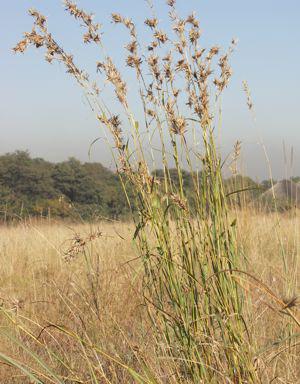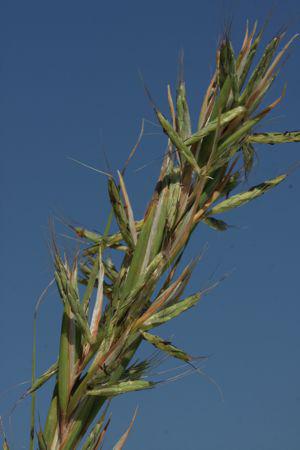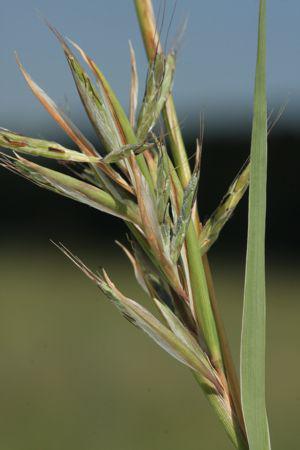Cymbopogon caesius
Cymbopogon caesius (Hook. & Arn.) Stapf
Family: Poaceae
Common names: common turpentine grass, broad-leaved turpentine grass (Eng.); lemoengras, buchugras (Afr.); iMbanjana (Ndebele); muWaa (Kalanga); Moshanyna-oa-marallaneng (SeSotho); imBubu, imBanjane (isiZulu).
Introduction
Cymbopogon caesius is a densely tufted perennial grass, which has swollen lowest racemes (an unbranched inflorescence axis with pedicellate spikelets) that are enclosed in a narrow spatheole. The leaves and inflorescences have a strongly aromatic turpentine smell when crushed.

Description
Description
Densely tufted, aromatic perennial, up to 1500 mm high; leaves mainly cauline; lowest culm nodes exposed, without old leaf sheaths. Leaf blade is 50–300 ×14 mm, rounded or cordate at base, apex a very long and fine point; ligule an unfringed membrane, 1–5 mm long.
Inflorescence is elongate; lower raceme with lowermost internode and pedicel swollen and fused together; internode and pedicel hairy along margins only. The sessile spikelet is 3.5–5.0 mm long; lower glume (the bracts at the base of the spikelet) with a deep narrow groove in lower half, 2-nerved, upper part broadly winged, wing scaberulous on margin; upper lemma (enclosing the grass flower) bifid to about middle, awn 7–14(–20) mm long. Pedicellate spikelet is 3–5 mm long, lower glume narrowly winged in upper part. Flowering mostly November to May.

Diheteropogon amplectens has similar leaf bases, but it is not aromatic and lacks a swollen lowest raceme base.
Conservation Status
Status
The SANBI Threatened Plants Programme (Red List of South African plants) has as yet not indicated its conservation status. Cymbopogon caesius in southern Africa is very common (http://Redlist.sanbi.org/cymbopogon accessed 12/05/2015).
Distribution and habitat
Distribution description
In South Africa it is widely distributed in all provinces, except the Western Cape. It is also distributed northwards through Africa to Sudan and Yemen; also southern India and Sri Lanka. It is common in areas that receive summer rain. It occurs in all altitudes on most soil types, but prefers open sourveld and hillsides, particularly on sandy soils and in relatively undisturbed areas. It often also grows along roadsides. In the tropics it is often found in open woodland.
Derivation of name and historical aspects
History
Cymbopogon derived from the Greek word kymbe for a ‘boat’ and pogon for a ‘beard’, which mean in most species, the hairy spikelets project from boat-shaped spathes. The specific epithet caesius is a Latin word for, ‘bluish grey’, as of eyes, which means the plant as a whole or in part is bluish grey. The genus Cymbopogon has ± 40 species occurring in tropical and subtropical Africa, Asia and Australia; 6 species are found mainly widespread in southern Africa.

Ecology
Ecology
Cymbopogon caesius is pollinated by wind, and seeds are also dispersed by wind and by water. It occurs in areas where annual rainfall exceeds 500 mm per annum, but may occur less frequently in areas with lower rainfall. Often found along roadsides, in pastures and cultivated fields, as well as in grasslands, savanna and forests, at altitudes ranging from 30 to 1 500 metres.
Uses
Use
Common turpentine is an aromatic grass. Used for thatching; smells and taste of turpentine, therefore highly unpalatable and thus, of poor forage value. Medicine such as ‘Sirri Oil’ is prepared from the roots and also decoctions of the rootstock are used by some Africans for stopping morning sickness in pregnant women. In Lesotho the grass used to keep rodents away from grain baskets and in South Africa used as a mosquito repellent. It contains an essential oil with almost 18 ingredients, of which carvone, trans-carveole and D-limonene are the most important.
Growing Cymbopogon caesius
Grow
Cymbopogon caesius grows mostly in sandy or gravel soil and forms hard tussocks.
It is easy to cultivate from seed, but do not forget to water your grass plants or grass seeds well, as soon as possible after planting. Settle them in and keep them on the wet side until they show signs of growing, thereafter, the amount of irrigation can be gradually reduced.
As a perennial grass it sprouts quickly after fire.
References
- Chippindall, L.K.A. & Crook, A.O. 1976. Grasses of southern Africa. Collins, Harare [Salisbury].
- Clifford, H.T. & Bostock, P.D. 2007. Etymological dictionary of grasses. Springer, Berlin, Heidelberg, New York.
- Gibbs Russell, G.E., Watson, L., Koekemoer, M., Smook, L., Barker, N.P., Anderson, H.M. & Dallwitz, M.J. 1990. Grasses of southern Africa. Memoirs of the Botanical Survey of South Africa No. 58.
- Leistner, O.A. (ed.). 2000. Seed plants of southern Africa: families and genera. Strelitzia 10. National Botanical Institute, Pretoria.
- Van Oudtshoorn, F. 1999. Guide to the grasses of southern Africa. Briza Publications, Pretoria.
Credits
Aluoneswi Caroline Mashau
Pretoria National Herbarium (PRE)
June 2015
Plant Attributes:
Plant Type: Grass
SA Distribution: Eastern Cape, Free State, Gauteng, KwaZulu-Natal, Limpopo, Mpumalanga, North West, Northern Cape
Soil type: Sandy
Flowering season: Early Summer, Late Summer, Autumn
PH:
Flower colour: Green, Purple
Aspect: Full Sun, Morning Sun (Semi Shade), Afternoon Sun (Semi Shade)
Gardening skill: Easy
Special Features:
Horticultural zones










Rate this article
Article well written and informative
Rate this plant
Is this an interesting plant?
Login to add your Comment
Back to topNot registered yet? Click here to register.